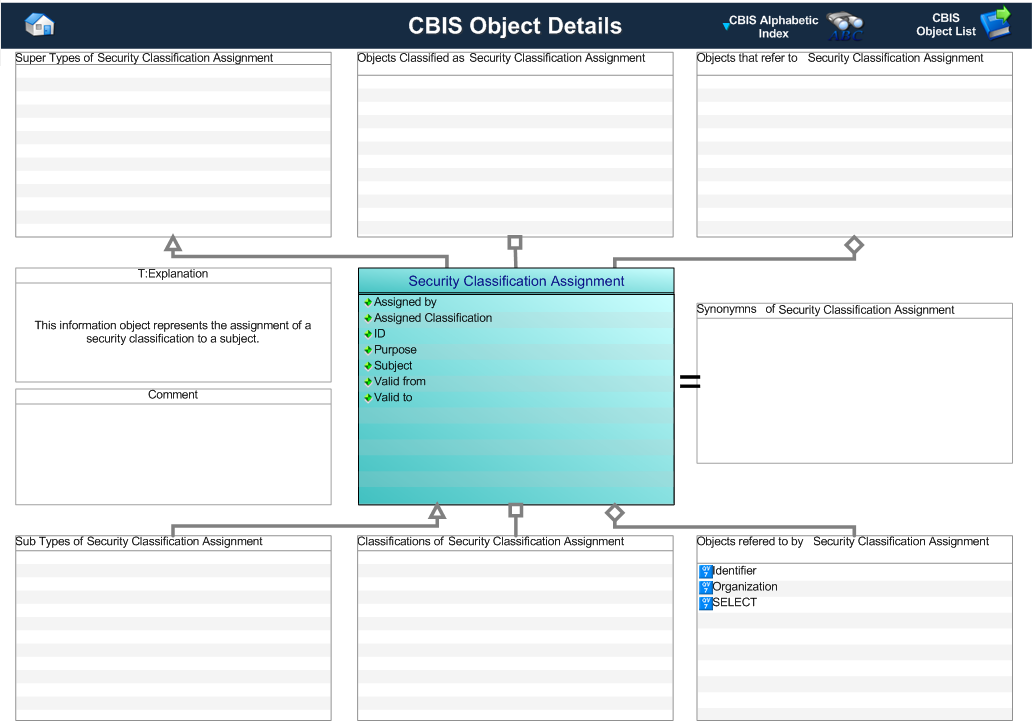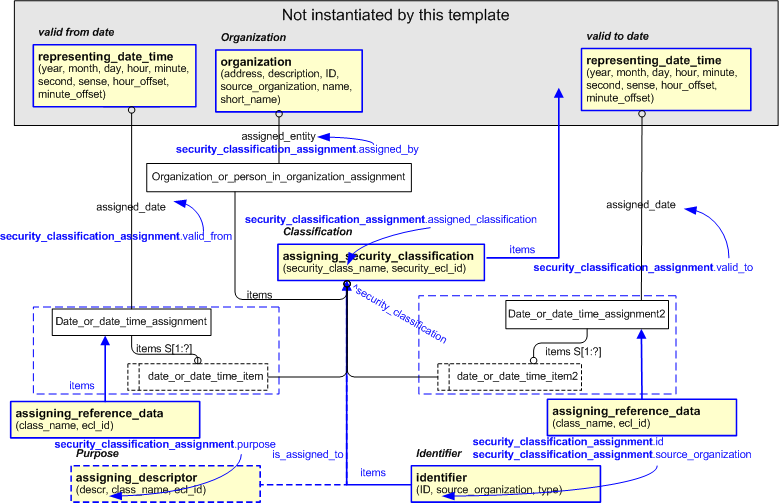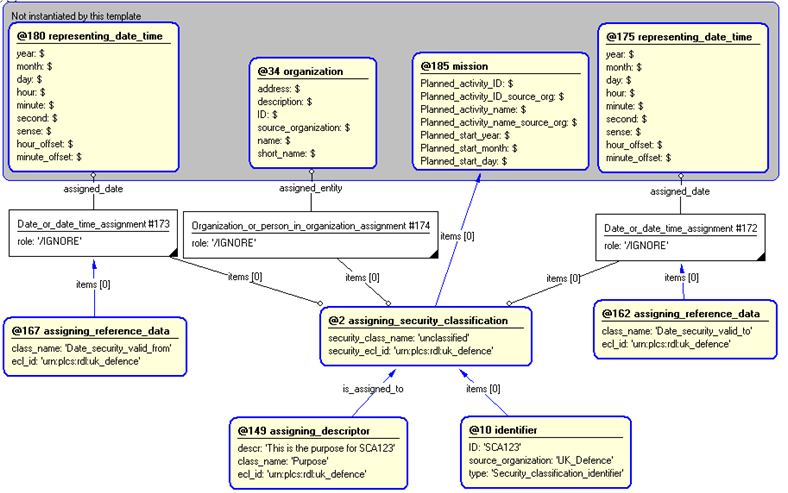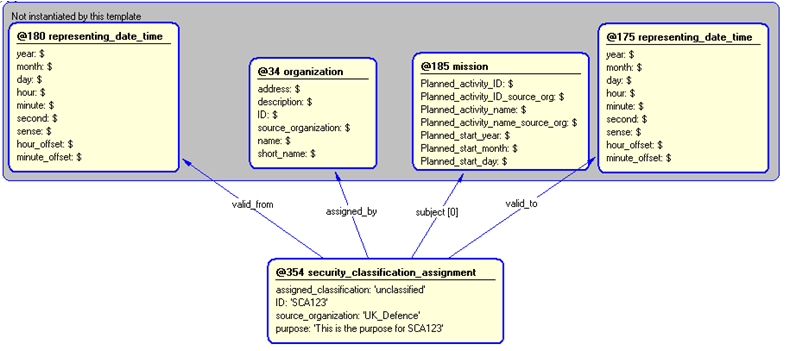Template:— security_classification_assignment (sec_cl_ass)
Context:— UK_Defence |
Date: 2009/04/17 11:42:30
Revision: 1.3
|
This section specifies the template security_classification_assignment.
NOTE
The template has been defined in the context of
UK_Defence.
Refer to the business context for details of related templates.
NOTE
An explanation of a template and the associated instantiation path is
provided in the
Template overview
section.
This template describes how to represent the assignment of a security classification to a subject.
The role change business object is used by those UK_Defence Data Exchange
Specifications that require information about the assignment of a security classification to a subject.
Figure 1 — Graphical Representation for Business Object Security Classification Assignment
Security Classification Assignment:
The definition of a Security Classification Assignment object is:
Data about the assignment of a security classification to a subject.
|
Attribute name
|
Attribute description
|
Attribute type
|
Optionality
|
| Assigned by |
This is the reference to the organization that assigns the classification. |
Relationship to Organization |
Mandatory |
| Assigned Classification |
This is the value of the security classification that is assigned.
Examples from DEF STAN 00-60 [DED 369, security classification] include:
"top secret",
"secret",
"confidential",
"unclassified",
"restricted",
"top secret atomic",
"secret atomic",
"confidential atomic".
|
Intrinsic |
Mandatory |
| ID |
This is the identifier of the security classification assignment |
Identifier |
Mandatory |
| Purpose |
This is the purpose of the assignment. |
Intrinsic |
Optional |
| Subject |
This is the reference to the subject to which the security classification is assigned. |
Relationship to Document, Message, Requirement, Zone, Inventory Item, Mission, Mission Type, Product,
Product Design, Facility or Support Feedback
|
Mandatory |
| Valid from |
This is the date and time from which the assignment is valid |
Intrinsic |
Optional |
| Valid to |
This is the date and time to which the assignment is valid |
Intrinsic |
Optional |
Table 1 — Security Classification Assignment attribute details
The EXPRESS-G diagram in
Figure
2
shows the templates and EXPRESS entities that are required
to represent the template
"security_classification_assignment".
The text highlighted in blue shows the template parameters.
Figure 2 — An EXPRESS-G representation of the Information model for security_classification_assignment
The graphic for the template to be used in other EXPRESS-G diagrams
is shown in Figure
3
below.
Figure 3 — The graphical representation of the security_classification_assignment template
The following input parameters are defined for this template:
This is the reference to the organization that assigns the classification.
This is the value of the security classification that is assigned.
The following classes and their sub-classes can be used:
classifications: [Uk_defence_security_classification]![[warning:]](../../../../../../images/dex/warning.gif) Error RDL4: The URI urn:plcs:rdl:uk_defence is not listed in dexlib/data/refdata/rdl_index.xml
Error RDL4: The URI urn:plcs:rdl:uk_defence is not listed in dexlib/data/refdata/rdl_index.xml
This is the identifier of the security classification assignment.
The organization that created the identifier. Additionally
a Person or Information System could be defined when either of these are the source; see Identifier template.
This is the purpose of the assignment.
This is the reference to the subject to which the security classification is assigned.
This is the date and time from which the assignment is valid.
This is the date and time to which the assignment is valid.
The following reference parameters are defined for this template:
%^target = $security_classification_assignment.security_classification%
The following parameter combinations specify a uniqueness constraint:
Unique constraint: Security_classification_assignment
The instantiation path shown below specifies the entities that are to be
instantiated by the template.
A description of templates and the syntax for the instantiation path is
provided in the
Templates Help/Information section.
/
assigning_security_classification(
security_class_name=@assigned_classification,
security_ecl_id='urn:plcs:rdl:uk_defence',
items=@subject)/
%^security_classification = $assigning_security_classification.security_classification%
-- assigned by (mandatory) Organization_or_person_in_organization_assignment-- Set the Organization_or_person_in_organization_assignment attribute role to be ignored Organization_or_person_in_organization_assignment.role = '/IGNORE'
Organization_or_person_in_organization_assignment.items ->
^security_classification
Organization_or_person_in_organization_assignment.assigned_entity ->
@assigned_by-- ID (mandatory) /
identifier(
ID=@ID,
source_organization=@source_organization,
type='Security_classification_identifier',
items=^security_classification)/
-- [optional purpose] /
assigning_descriptor(
descr=@purpose,
class_name='Purpose',
ecl_id='urn:plcs:rdl:uk_defence',
is_assigned_to=^security_classification)/
-- [optional valid from] Date_or_date_time_assignmentDate_or_date_time_assignment.items ->
^security_classification
Date_or_date_time_assignment.assigned_date ->
@valid_from%^valid_from_time =
Date_or_date_time_assignment%
/
assigning_reference_data(
items=^valid_from_time,
class_name='Date_security_valid_from',
ecl_id='urn:plcs:rdl:uk_defence')/
-- [optional valid to] Date_or_date_time_assignmentDate_or_date_time_assignment.items ->
^security_classification
Date_or_date_time_assignment.assigned_date ->
@valid_to%^valid_to_time =
Date_or_date_time_assignment%
/
assigning_reference_data(
items=^valid_to_time,
class_name='Date_security_valid_to',
ecl_id='urn:plcs:rdl:uk_defence')/
The following entities are instantiated with attributes as specified:
The instance diagram in Figure
4
shows an example of the EXPRESS entities and templates that are instantiated by the template:
/security_classification_assignment(assigned_by='@34', assigned_classification='unclassified', ID='SCA123', source_organization='UK_Defence', purpose='This is the purpose for SCA123', subject='@116', valid_from='@180', valid_to='@175')/
(an illustration of the consolidated security_classification_assignment template is shown in
Figure
5 below.)
Figure 4 — Entities instantiated by security_classification_assignment template
The instance diagram in
Figure
5
shows the graphic symbol for the template that is to be
used in other instance diagrams. The example template is:
/security_classification_assignment(assigned_by='@34', assigned_classification='unclassified', ID='SCA123', source_organization='UK_Defence', purpose='This is the purpose for SCA123', subject='@116', valid_from='@180', valid_to='@175')/
Figure 5 — Instantiation of security_classification_assignment template
Characterizations
No common characterizations of the template
security_classification_assignment
have been identified. However, the ISO 10303-239 EXPRESS model
may enable other assignments to the entities instantiated by the template.




